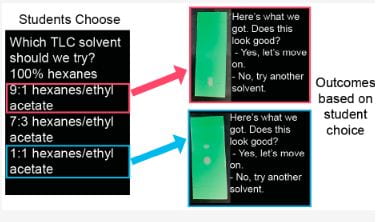Claire Freimark, School of Biological Sciences
Introductory undergraduate science courses can be intimidating. Large class sizes, long lectures, and cumulative exams can lead to high stress levels, poor student attitudes, and low retention rates in STEM majors. Many introductory courses are taught in a traditional lecture format; these in particular do not spark student engagement, enthusiasm, or motivation. While science instructors are often encouraged to incorporate active learning into their courses, it can be difficult to implement in large classes. There may be an increase in the organizational work or grading required, and effort is needed to develop a new curriculum.
Why use active learning?
The use of active learning strategies in science courses has been shown to improve student attitudes and performance (Armbruster et al. 2009) and narrow the achievement gap for underrepresented students (Theobald et al. 2020). The latter is especially important, as underrepresented minority and low-income students that enter college with an interest in pursuing a STEM degree have lower degree completion rates than their peers (Theobald et al. 2020).
With the clear benefits of active learning for introductory science courses, how can instructors implement them in large-enrollment classes? Allen and Tanner (2005) reviewed a variety of possible methods. These methods vary in the preparation and time required to implement them, and several are highlighted below.
-
- Questions that prompt student discussion
Instructors can pose questions throughout a lecture period that elicit class discussions. This may take the form of a think-pair-share exercise, which will allow for both student-to-student and student-to-instructor interaction. - Classroom technology for immediate feedback
iClickers and similar classroom technology, such as Mentimeter and Kahoot!, provide both instructors and students with immediate feedback on student understanding of class material. In a study by Armbruster et al. (2009), students ranked iClicker questions as one of the most helpful active learning strategies for their own learning. - Problem-based learning and case studies
Case studies allow students to work together to solve real-world scenarios, allowing them to “think like scientists” and develop necessary professional skills. They can be combined with classroom technology, allowing instructors to monitor student understanding in real-time. For example, in a study by Cleveland et al. (2017) the instructor utilized an “interrupted case” format. With this strategy, the instructor presents case study information in a narrative format, followed by a series of iClicker questions. Case studies have been shown to improve students’ analytical skills, higher-order thinking, and exam performance and increase their motivation and engagement (Bonney 2015, Cleveland et al. 2017).
- Questions that prompt student discussion
Which active learning strategy should instructors choose?
There is not a one-size-fits-all answer. It depends on several factors: the time the instructor can dedicate to active learning, their background and experience, and the classroom structure, among others. For example, the layout of lecture halls may limit the possible active learning strategies, with iClicker or think-pair-share exercises being most appropriate. In other classrooms, the layout may better permit small group discussions. Additionally, instructors that are short on preparation time may be best able to implement iClickers, think-pair-share, or other strategies that require relatively little planning. On the other hand, case studies and more extensive group discussions may require more preparation work, which for some instructors can be time-prohibiting.
With all those factors to consider, instructors should choose the active learning strategy that best fits their classroom, experience, and time constraints. As long as some form of active learning is incorporated, students will reap the benefits! Cleveland et al. (2017) found no difference in student learning gains when instructors used different active learning strategies if they were implemented for the same amount of time. Additionally, instructors with different backgrounds were equally successful in implementing active learning (Cleveland et al. 2017).
Thus, the most appropriate active learning strategy depends on a variety of factors, which instructors must consider when planning their course. However, instructors should not worry about choosing the “best” form of active learning. Instead, they should use whichever strategy they are most familiar with and comfortable incorporating into their own classroom.
References
Allen, D., & Tanner, K. (2005). Infusing Active Learning into the Large-enrollment Biology Class: Seven Strategies, from the Simple to Complex. Cell Biology Education, 4, 262–268. https://doi.org/10.1187/cbe.05-08-0113
Armbruster, P., Patel, M., Johnson, E., & Weiss, M. (2009). Article Active Learning and Student-centered Pedagogy Improve Student Attitudes and Performance in Introductory Biology. Life Sciences Education, 8, 203–213. https://doi.org/10.1187/cbe.09
Bonney, K. M. (2015). Case Study Teaching Method Improves Student Performance and Perceptions of Learning Gains. Journal of Microbiology & Biology Education, 16(1), 21–28. https://doi.org/10.1128/JMBE.V16I1.846
Cleveland, L. M., Olimpo, J. T., & DeChenne-Peters, S. E. (2017). Investigating the Relationship between Instructors’ Use of Active-Learning Strategies and Students’ Conceptual Understanding and Affective Changes in Introductory Biology: A Comparison of Two Active-Learning Environments. Life Sciences Education, 16(2), 1–10. https://doi.org/https://doi.org/10.1187/cbe.16-06-0181
Theobald, E. J., Hill, M. J., Tran, E., Agrawal, S., Arroyo, E. N., Behling, S., … Freeman, S. (2020). Active learning narrows achievement gaps for underrepresented students in undergraduate science, technology, engineering, and math. PNAS, 117(12), 6476–6483. https://doi.org/10.1073/pnas.1916903117/-/DCSupplemental

